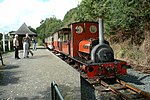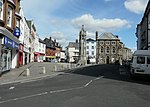Launceston railway station
Launceston railway station (Cornish: Lannstevan) was situated in Launceston, Cornwall, United Kingdom. It was served by both the Great Western Railway (GWR) and London and South Western Railway (LSWR). There were actually two stations adjacent to each other, the northern station serving the line to Plymouth, which was built by the Launceston and South Devon Railway (later GWR), and the southern station being on the North Cornwall Railway (for the LSWR) which was operated by the London and South Western Railway. The two stations unusually shared a "back to back" signal box from 1916, despite being operated by different railway companies. A connection between the two railways was provided in 1943. The GWR station closed to passengers in 1952, all trains then using the LSWR station. The Launceston Steam Railway now operates nearby.
Excerpt from the Wikipedia article Launceston railway station (License: CC BY-SA 3.0, Authors).Launceston railway station
Priory Park Road,
Geographical coordinates (GPS) Address Nearby Places Show on map
Geographical coordinates (GPS)
| Latitude | Longitude |
|---|---|
| N 50.64 ° | E -4.365 ° |
Address
Priory Park Road
Priory Park Road
PL15 8JB
England, United Kingdom
Open on Google Maps






